"Because it's Japan" I will be studying abroad in Japan for the third time in spring 2019. My school requires me to make certain posts here, but I'll do my best to add my own content.
Don't wanna be here? Send us removal request.
Photo


Paper star mobile room decor☆ ✼hometalk.com
How to origami paper star ✼dumpaday.com
2K notes
·
View notes
Photo

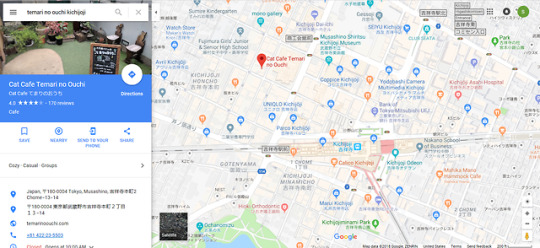
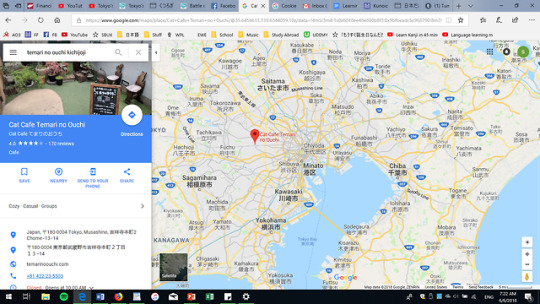
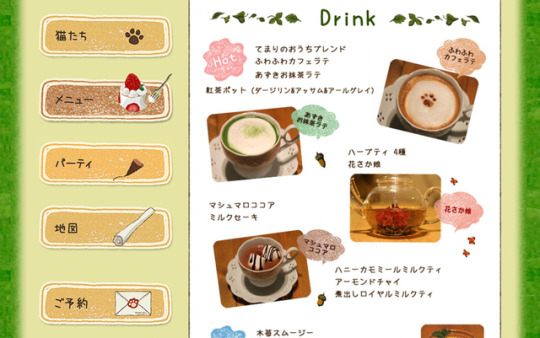
Oooh, this was so hard just picking one place to visit/thing to do, but it was kind of an obvious choice after I saw the previously posted video (Simon and Martina give me life.) My two previous times abroad I never went to a cat café and so! I want to go to a cat café. This (temarinoouchi.com) cat café. I agree with Simon and Martina that it looks like it’s straight out of a Studio Ghibli film and so I must see it. I will also be missing my two cats dearly, so I’m willing to travel an hour and a half to see cats.
I couldn’t find a date of establishment on their website, but they’ve been around at least since 2013, because that’s how far back their blog posts go. (Some of these posts are adorable! They post about celebrating individual cats’ birthdays and the presents that they get.) I can also tell you they have about 20 cats and I wanna go all cat lady on them already. Especially this sweet bean, Maachi. “Temari no Ouchi” means something to the effect of “Your home’s yarn ball.” “Temari” is a traditional Japanese handball game that features gorgeously detailed balls of string (see above). I would also highly recommend doing additional image searches for them, they are fantastic. The cats will sometimes be put in little bibs and bandanas.
It’s located in Kichijoji, Tokyo (see maps), and it’s less than a 10-minute walk from Kichijoji Station (though that’s an hour and a half from me). It’s highly recommended that you make a reservation for the café because they often reach capacity early. There are a few common sense-type rules in the café: no flash photos, don’t feed the cats any people food you order from the café (though you can order treats for the cats! for about $3), and no rough playing with the cats. If you need staff member but don’t see one, there’s a rooster-shaped bell, and you can ring it (gently) to call a staff member. From 6 to 7pm, the cats are fed dinner in front of café patrons, so all roughly 20 cats are called into a circle for dinner, so you can see all the cats together.
There is food and drink for the humans too! Temari no Ouchi has a decent-sized human menu for a place that specializes in cats. They have their own blend of coffee, a “fluffy” latte, a green tea latte with sweet red beans, and a few other hot drinks. They also have cold drinks, dessert parfaits, scones and cakes, lunch foods, and they even serve alcohol. You can reserve the whole café for parties for 2 and 3-hour increments.
0 notes
Video
youtube
Simon and Martina at Temari no Ouchi Cate Café in Kichijoji, Tokyo
0 notes
Text
Final Journal
(Guess who misplaced their external hard drive again? Otherwise there would be more Japan pictures here -_-’)
I’m not leaving for a while yet, but that does not mean I have not made plans.
I have quite a list of goals I’d like to achieve (looking at my learning contract), but it’s unrealistic to expect to meet all of them in the few short months that I’m there. Some are simple. For example, when I was abroad both times previously, I took over 6,000 pictures combined. But the majority were pictures of famous sites that I can find online, and of better quality. I wish I had taken more photos of the things I ate, my route to school, my host families. Things that aren’t online and aren’t easily found. I also wish I had taken pictures when I was in a particular mood and certain times of day, like at dusk in the summer months I was walking home from school. That time of day made me feel something that’s hard to explain, but the difference in feeling from the summer month of august I arrived in, to the summer month of July the next year were very different, and I wish I had documented it. So my measurable goal while I’m gone is to take at least 10 pictures every day. At least one picture of anything and everything I eat that is not something I used to make at home, pictures of flowers along my walk, pictures of manhole covers along my walk (each town is different, and of course Japan would make them pretty to look at too), and I want one good sound recording of a Japanese crow cawing. There’s nothing quite like it.
My second goal is everything food. I want to lose weight before I go and keep it off as best I can while I’m there so I can eat anything and everything I want without having to change clothing sizes too many times. My first time in Japan I went up a pant size, and I don’t regret eating the food or gaining the weight at all. I enjoyed 98% of the things I ate immensely. But I regret the week and a half I had to wait anxiously for the bigger pants my mom shipped to get there (yes, I shipped my pants). Thank goodness for my school uniform and pyjama pants, or I would have had no bottoms to wear in winter. So this one is not so measurable, but same as my two prior times abroad, I want to eat what I want when I want it. Japanese food culture is such a fascinating and delicious aspect of Japan.
Finally, I want to know my host city better. I did pathetically little exploring on my own the first time, and there were a myriad of reasons (ahem, excuuuuuses) and I am nothing but ashamed and regretful, and I don’t want to feel the same way this time. So my goal is to spend one full day every week (barring previously scheduled mandatory events) picking a random direction in my city and waking around (or biking around). I have a train pass from last time, but a bus pass would be helpful too, I think. I really want to get a bike while I’m there because I loved biking to get around and it’s so helpful when you buy things.
0 notes
Text
Learning Contract
Academic
· Japanese communication
o I want to get better at overall at communicating in Japanese. Some of these things include:
§ Response time (how long does it take me to formulate an answer)
§ Quality of response (do I know the words I want to use, and am I using them correctly)
§ Can I enunciate and pronounce words and phrases well? Or do I stutter and stumble
§ Comprehension (do people know what I’m saying)
§ My personal comprehension (am I able to understand what someone else is asking or saying, and to what extent)
§ Verb conjugation/tenses (whether spoken or written, I have trouble with which verb conjugation/modification means what)
· Japanese listening comprehension
o My listening comprehension skill are not the best, I’ll be honest. Part of that is that I do have some hearing loss, so even listening to English conversations can be tough. So goals here are:
§ How fast is too fast? (what kind of speed can I work up to being able to understand? Half-speed? Normal, native speed? Fast-paced conversation speed?)
§ How accurate is my understanding of what is being said. What percent of the conversation/dialogue can I understand
· Japanese reading/kanji/handwriting
o I know I don’t know enough kanji to be able to truly get by, and I’m even worse at using them when I write. Explicit goals are:
§ Being able to read (pronounce and understand) at least 1,000 kanji
· Keep track- based on JLPT levels
§ Being able to recall without checking and write at least 750 kanji
· Keep track- based on JLPT levels
§ Again, verb conjugations and tenses (more able to comprehend and understand while reading, and recall them to use them when writing)
§ Make my handwriting more consistent and accurate (do I write one character or kana in a way that looks like another? Is my handwriting messy, disorganized, or inconsistently spaced?)
§ Improve writing speed (can I learn to write faster without losing legibility?)
· Join a school club based in Japanese culture, etc.
o Self-explanatory. Join a club! Goal is to make friends and learn something, and be involved with the campus community
· Be able to have a 5-minute conversation with host families with minimal English, and as few gaps as possible (goes along with comprehension)
· Attend 90% of the classes (self-explanatory, track your own attendance)
· Take part in college’s weekend homestay (practical language practice)
Global
· Network/make friends with other foreign students
o Socialize! How many friends do you have contact info for? (Facebook, phone numbers, LINE IDs)
· Network/make friends with Japanese students
o Same!
· Get involved with international clubs on campus
o Get involved in at least one international club that is not North American culture-based.
· Better understand where Japan fits in their region of the world, and the world as a whole
o Try to take a class that has something to do with politics, or modern-day Japan
· Have a more in-depth understanding of modern Japanese history (and how it has impacted present-day Japan)
o Take a history class if possible. If not, watch or read the news
· Better understand the issues (issues with neighboring countries, labor shortage, PEOPLE shortage) that Japan will face in the future
o Again, watch or read the news. Ask host family and friends if you have questions.
Personal
· Learn how to deal with living alone
o How often do I feel uncomfortable about living by myself
· Learn how to meal plan
o Can make several meals from one shopping trip
· Learn how to cook Japanese meals
o Buy a cookbook or print recipes, and try making meals
· Learn how to cook meals from home, and other countries besides Japan (possibly through friends!)
o Cook together! Share recipes!
· Meet with my host families and old friends and maintain and grow those relationships
o Make contact sometime before leaving – grow and maintain those relationships
· Plan most of my trips around Japan on my own
· Be more comfortable making mistakes
· Learn how to take better care of myself (eating better, getting in shape, etc.)
· See if there are any job fairs while there
1 note
·
View note
Text
Journal 10
Last week of school! Except it’s not for me. Our last journal is a response to Maximizing Study Abroad readings and What’s Up With Culture? readings. The MSA readings were on the topic of nonverbal communication, which consists of things like hand gestures, body language, eye contact, facial expressions, personal space, and touching. These forms of nonverbal communication and social norms are learned through observation by both native users of culture and nonnative users.
The first exercise was a series of pictures where we would comment on what the particular gesture means in our home country, and then what the gesture may mean in our host country. The first picture is what we would call the “okay” gesture, where we make a circle with our forefinger and thumb, and the remaining three fingers are left straight. As I said, this is the “okay” gesture in the U.S., but from past experience I know in Japan that this hand gesture means “money.” In other parts of the world, it means “A**hole.” The second gesture is two palms pressed together, and here that could meaning a symbol of prayer, or “please?” In Japan, the gesture has, as far as I know, the exact same meaning. When you ask for a favor in Japan, you see people using this gesture. You also see it in prayer.
Skipping along to eye contact, this is kind of an interesting topic. The activity for eye contact was how much eye contact we prefer in different situations, such as chatting with various people, talking in a professional setting, or giving a presentation. For most Americans, making eye contact with people shows that you are engaged in speaking, interested, and not trying to hide anything, and so people make direct eye contact quite often. However, when I did this in Japan, I could tell it made people uncomfortable. They never made sustained eye contact with me, they tended to glance quickly and then look somewhere else. In Japan, I learned, direct sustained eye contact shows aggression. This wasn’t explained to me until the last few months of my exchange, and so I understood then why my teachers always seemed uncomfortable talking to me. I thought I was showing that I was listening and engaged, and they thought something very different.
Personal distance was the next topic in the reading, and the activity asked us how much distance we prefer to be from people when we talk with friends, teachers, interview for a job, give a presentation, place an order with a waiter, and talk to family. In that order, if I speak with close friends I stand close, less close friends I speak to usually at an arms’ length, and the same with teachers. For every job interview I’ve had, I’ve been asked to sit, so there’s either the distance of the table, or the distance between chairs, which would vary. When someone is giving a presentation, they’re typically at the front of the room where everyone can see them, and are quite far from others, and thus need to project their voice. When placing an order, it’s usually the distance of the table, and when I talk to my family it varies. If we’re at opposite ends of the house, we have shout and have conversations. In Japan, it’s much the same way, the difference I noticed though is that even between friends and family, there is usually about an arms’ length distance between people conversing.
0 notes
Photo
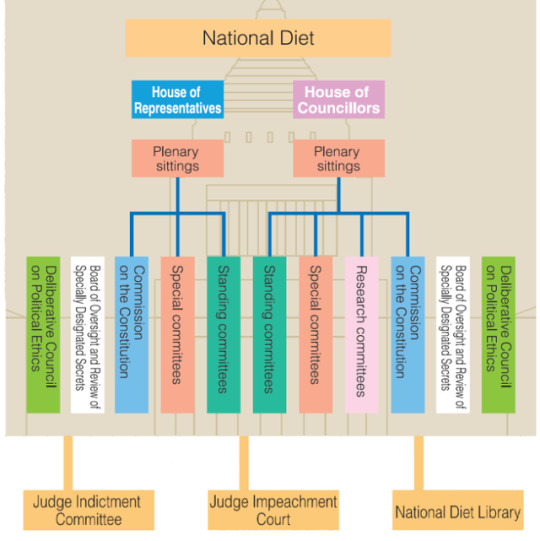
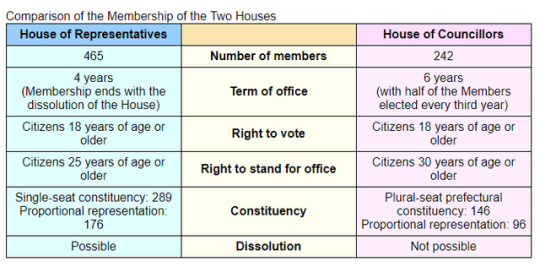
Japan's current constitution was written almost immediately after World War II, and implemented in 1946. Japan’s government is considered a parliamentary government with a constitutional monarchy. Japan has an emperor who is a symbol of the state and has few if any effective powers. The emperor inherits his position, though all other branches of government are elected bodies. The emperor's duties consist mainly of formalities, such as appointing the Diet-elected prime ministers, closing Diet sessions, and awarding state honors. There are three branches of government, and much like the United States they are legislative, judicial, and executive.
The Japanese elected legislative body is called the Diet. There are two houses within the Diet, the House of Representatives and the House of Councillors. Decisions made in the House of Representatives take precedence over whatever outcomes are reached in the House of Councillors. The Diet as a whole “is responsible for making laws, approving the annual national budget, and initiating the drafting of constitutional amendments” (MSU). Representatives must be at least 25 years of age, and terms are for 4 years, and for Councillors the minimum age is 30, and terms are for 6 years, with half of the Councillors up for reelection every 3 years. There are 242 seats in the House of Councillors, and 465 in the House of Representatives.
The judicial branch of government is completely independent of the other two branches. There are three levels of courts in most of the country. Within the highest court, the Supreme Court, there is one chief justice and fourteen other justices. When the prime minister decides the cabinet, he also chooses a chief justice and then the other justices are put forth but the elected cabinet. Justice positions are then put to a national vote, and a general election is held every 10 years after that. The voting age in Japan is 20 years.
The Diet is currently trying to create budget targets for the 2020s, but the decision is being pushed back over conflicts of opinion on welfare and spending cuts. The goal is to give Japan a budget surplus sometime in the mid-2020s.
Sources:
Diet Makeup and Stats (also the picture source)
Britannica
Michigan State University Analysis
Japan-Guide.com
New Japan Budget
0 notes
Text
Blog 9
So! For this week’s blog, I realize I got a little messed up with what assignments go what week. I guess the culture shock thing I did last week was included in this week? I’m not sure anymore. Regardless, this week’s blog assignment had some practice scenarios for high and low context cultural responses. We had an activity where we were given a sample situation and response, and we had to identify if it was a high or low context culture response. I got all of them correct, though I was a little confused for number 9. Number 9 was: you feel that hinting at something is an effective way of getting what you want. I didn’t answer this question, because I’ve seen some pretty heavy-handed, super-obvious hint-dropping, and that to me says low context. However, if the hinting is subtle, then I would agree that it’s high context communication. In this particular problem, it was indeed high context.
The other little activity we were supposed to do was about communication styles. We were given an explanation of each communication style (they came in inverse pairs on a spectrum), and then what a response within that style might look like. Our task was to plot where we personally fall on the spectrum, where our host country falls, and then where our home country falls. The communication pairs were: indirect and direct; linear and circular; detached and attached; and idea-oriented and relationship-oriented. My personal answers went: indirect, linear, midway between attached and detached, and relationship. My answers for Japan were: indirect, unsure, detached, and relationship. My answers for the U.S. were: midway between direct and indirect, linear, midway between detached and attached, and midway between relationship and idea. This activity was easy to answer in terms of myself, but difficult to answer about Japan and the U.S. because I hate the idea of being so inflexible. Generally, I agree with what I answered, but we know that different situations arise where a response may be different, and people themselves are rarely one way or another.
So there’s just one more week left to go, huh?
0 notes
Photo
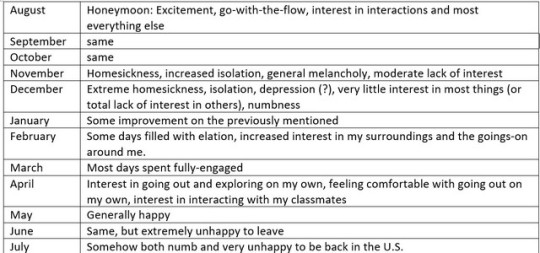
We’re on to culture shock and (cross-) cultural adjustment! Another interesting topic for me. Honestly, the first time I went, even though the organization I went through explained all this to us and gave us charts (I couldn’t a chart that I really liked, so please give a search a look at a few different ones) and anecdotes, I still didn’t realize how I was experiencing culture shock until about 4 months in. I made chart laying out my general reactions and experience with culture shock, but let me give some background.
I went to Japan for the first time in August at the beginning of my last year of high school. I had less than a week to “adjust” before I was put into a Japanese public high school. I had no Japanese language or culture experience, and my “research” only went so far. My first host mother spoke English, and my homeroom teacher in school was the English teacher, so if I had issues, it was easy enough to ask for help (in English, because I both anxious and somewhat lazy). All six of my host families had at least one English speaker, so looking back I was in the honeymoon stage for almost 2 months. Around the end of November, around Thanksgiving was when I started feeling low for a variety of reasons. The weather was getting colder, the days shorter, there were major family holidays and events happening back in the U.S. without me, and when I changed families my house was super far from school, and the bike ride home took so long I decided to stop going to badminton. I stayed low for almost all of December. I wouldn’t say I was depressed per se, but towards a lot of things I was numb or totally disengaged towards. Honestly, the month of December is a bit of a blur. Looking back, I took the least amount of pictures in December, and I took almost 5,000 over the course of the year.
January was also somewhat of a blur, but my general emotional recollection of it is more positive feeling than December. The end of January I changed families again, and this time, my fourth family was different from three previous in that they had young children, aged three and five. I hadn’t really had exposure to young children even in the U.S., because that was just how it was, so being around children was a totally new and riveting things for me. I could keep up with their Japanese because it was so much simpler. They were adorable and energetic, and interested in interacting with me, and so it was impossible to withdraw and be numb. I really credit these two girls with helping me out of my slump.
Around the same time I started going back to badminton, because I was closer to school again. I had two outings with the other exchange students in the area, so I wanted to be engaged with what was happening around me again. My host mom planned family outings, so I was actively interested in learning about Japan again, and seeing more of my host prefecture. February and March were good months. April was much the same way. I switched to my fifth host family, and they had a daughter that was going to study abroad in southern Illinois, so I was plenty interested.
The last few months of my exchange were generally happy, though I had a whirlwind few days in May. My fifth family took me on a trip over Golden Week, a collection of holidays all together in Japan. I remember very clearly having my mind run around in circles for two of the days on the bus. I was teeter-tottering between: being ashamed of myself for (in my opinion) wasting my exchange (in that I had gained very little in terms of language ability), letting all of my host families and the Rotarians down, as well as myself, and being fearful that I would never make it back to Japan; and then telling myself that I would come back, and I would keep learning Japanese, that all this time and effort was not a waste, and you sort of get the picture. June was wrapping things up, and then I left the first week of July.
0 notes
Photo

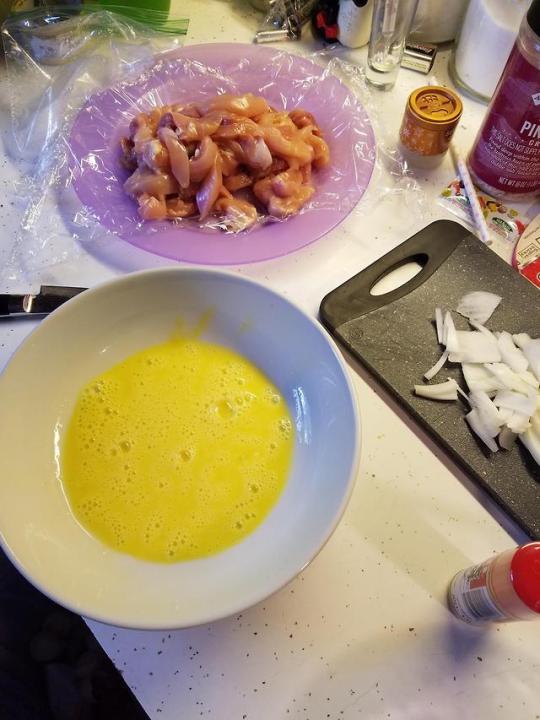
This week's blog is about food! I miss Japanese food and food culture like a limb. I have so many good memories that centered around eating food with great people during both my times in Japan. I chose to make one of my favorite Japanese comfort foods, oyakodon.
Some background: oyakodon is sliced chicken, onion, and egg that's been cooked in a sweet and salty broth made from dashi, sake, sugar, and soy sauce (See linked recipe). "Oya" means "parent," and "ko" means "child," which is meant to describe the chicken and the egg in this dish, which leaves me with a kind of awkward feeling, but there you go. "Don" is attached to meals that feature something over rice in a bowl. Some other examples of bowl meals are katsudon (fried pork cutlet bowl) and gyuudon (beef bowl).
The bowl is meant to be a meal on its own, but you can add things like vegetables, pickles, and miso soup as sides. Altogether this took roughly half an hour to make.
Oyakodon Recipe
0 notes
Photo

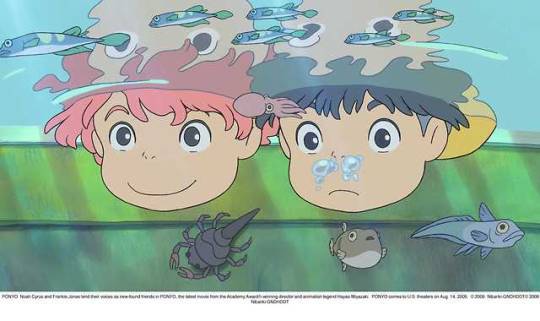
This week’s blog was to choose a movie and to note cultural dimensions. I chose the movie Ponyo, which is very loosely based off of The Little Mermaid by Hans Christian Andersen. This movie was created by the Japanese animation studio, Studio Ghibli. Ghibli was also responsible for Spirited Away (which won an Academy Award!), Howl’s Moving Castle, Kiki’s Delivery Service, My Neighbor Totoro, and Princess Mononoke. Let me just share that I own all of these, and Kiki’s Delivery Service was my favorite movie as a child. Ponyo shares themes with many of these movies.
Summary: Released in 2008 and directed by Studio Ghibli’s cofounder Hayao Miyazaki, Ponyo follows a goldfish princess who sneaks off from an outing with her father, and ends up making friends with a young boy named Sousuke. Sousuke names her Ponyo, and eventually Ponyo gains human arms and legs. Ponyo escaping from her father and becoming human creates magical backlash creating a storm and tsunami, and the world floods. While trying to get to Sousuke’s mother who works at a nursing home, Ponyo starts to revert back to a fish. Ponyo’s mother says that if Sousuke passes a test, then Ponyo will be fine, but if he should fail, Ponyo will turn into sea foam.
Photo Sources:
Movie Poster
Ponyo and Sousuke
0 notes
Text
Mentor report
We’re at Week 7! This week’s journal assignment was to meet with someone that had ideally done our specific program, or at least our country of study. I was fortunate enough to be able to talk to two people, one who did my specific program, and another who went to Nagoya. Both spent this past fall term abroad, and were eager to share their experiences with me. Gotta be honest though, they weren’t ecstatic about the questions though. But here we go.
You have been learning about what your host culture SHOULD be like (e.g., collectivist, focused on hierarchy, close personal distance). Review what you have learned and what you have read in MSA and in your destination-specific travel guide and ask your mentor: Is it really like that? How is it different from how the book and other resources portray it?
A lot of what I’ve researched or seen mentioned in my travel guide was relevant. My own past experiences, as well as my conversations with the two students who have gone to Japan also agree for the most part that: Japan is hierarchical. How you are treated depends a lot on where you score in your social standing. Japan has both individualistic and collectivist tendencies. They like to perform well in school and work, however, if you work in a company, all decisions are a team effort, and you can’t move forward unless everyone agrees. In schools, there are many group-oriented activities, and people look out for each other.
What is the biggest difference between our (US) culture and the host culture?
One of my mentors and I had differing opinions here. I felt that Japan being a high context culture was overwhelmingly difficult to deal with, but that may have been due to the fact that I lived with host families who either had quite a bit of experience dealing with foreigners, and then other families who had very little exposure to non-Japanese. I did have some difficulties with all of my families relating to what they expected me to know or be able to do, and me not having any idea what was going on. I was also 17 and eager to please, so all my nodding and smiling to everything made for some interesting situations.
My mentor felt that the level of responsibility one was expected to have was difficult to deal with. That they were supposed to join clubs and go to school and take care of themselves, etc. This I think is overwhelming for some people anyway, but add in needing to adapt to a new language and culture all on your own and it’s no wonder people have trouble handling so many responsibilities.
What is the biggest cultural similarity?
We all generally agreed that people were helpful if you asked politely.
What is the most important thing I should know about the language(s) in my host culture?
Verbs, verbs, verbs, and their level of politeness. There’s like 3 different verbs for “to give” depending on who’s involved. Verbs are so important!
What is the thing that surprised you most about the culture and/or the people of the culture?
All the things they are able to accomplish in a day, or any other given period of time. They are efficient, dedicated, and motivated in a way I wish I could be.
How does the host culture typically view Americans?
Depends on who you ask, and depends on what capacity Americans are there in. American military personnel will get a very different reaction from people depending on who you ask and where they are. Okinawans right now are not overly fond of American servicemen. Most Japanese are fine with American tourists, though would greatly appreciate it if people did a little more research on Japanese culture before they get to Japan. American students I like are well-received so long as they’re polite.
If the person was in the same program: what are the most important things to know about the academic expectations?
Attend your classes and do your homework. I was not surprised to hear that there were students in the classes taught in Japanese that were asleep. Something about that isn’t as offensive in Japan as it would be in a Western country. It may have something to do with the idea that if you’re sleeping, you must have been working hard the night before, and are then trying to recover. As I said, interesting.
What is the one thing you wish you knew before you left?
One mentor mentioned fashion quite a bit. Hey wished they had brought flare jeans. I am going while it’s warmer (“warm,” haha, ha.), so I might bring maybe one pair of jeans if I go for only one term. The other enjoyed the experience as it was, but wished they had brought more American snacks to share with people.
Are there any cultural taboos? Things I should avoid saying or doing?
Girls don’t show cleavage. We all agreed on that. Short-shorts are fine though. Don’t ride your bike with your umbrella open, that’s apparently illegal (it is). As for cultural taboos, you will almost never get an explicit “no” to something. However, there are plenty of both verbal and nonverbal cues that should tell you they mean “no” and to not push it. Don’t be super loud or rowdy in public, don’t make life inconvenient or difficult for others.
What is the most important thing I should know about the culture?
Respect for others I think is tantamount. As I previously stated in as many words, don’t inconvenience people. Don’t be rude or get in their faces if you don’t like the answer you’re being given. Japanese hate confrontation, and they hate losing face. Seriously consider how your actions affect those around you.
0 notes
Text
Beginner Japanese Resources

I’ve seen quite a lot of these going around, and have definitely taken quite a few pages out of their books, but I thought I had some bookmarks I’d like everyone to know more about, even if they already did. ^^ If you think something is wrong, or know something is wrong, then please tell me!
g r a m m a r
Tae Kim’s Guide to Japanese Grammar (easy acquaintance with grammar, but not much in-depth)
IMABI (best free grammar resource but too much information for beginners, or so it’s said. still very helpful.)
Tim’s Takamatsu/ Tim Sensei’s Corner (also good. i heard of someone who printed out the older website and got fluent in Japanese with this, so it’s probably worth checking out)
Dictionaries of Japanese Grammar (hands down the best grammar resource, bit pricey or you could just download these PDFs).
Bunpro (good for interactive grammar studies, free until may 10 and there’s a one month free trial for subscription after that)
g r a m m a r / b l o g s
Japanese Ammo (native speaker and tutor’s blog, she also has a Youtube channel here)
Maggie-Sensei (grammar articles are a bit mismatched but good for little references)
Tofugu (probably the best culture and resources blog I’ve come across. a must.)
Romy-sensei (Japanese teacher, blog is VERY helpful)
DJT Guide (for a beginner outlook on how to start and where, named because of the daily japanese thread that I don’t have too much information on but it’s a daily thread where people learning japanese shared resources/ progress/ motivational whatevers)
i n t e r a c t i v e l e a r n i n g
Delvin Language (shows clips and asks you to identify what’s spoken. Very good for listening and you can slow them down, though use that sparingly. kinda spammy tho.)
Japanese Class (found this a few years ago, but it’s a gamified site that helps you learn vocabulary with regular exposure. recommended.)
Japanese in Anime and Manga (for fellow otakus. a bit hard for me to navigate, but it’s along a similar vein as the above site. offered in spanish, chinese, korean and french, besides english.)
Erin’s Challenge (recommended for upper beginners, or lower intermediates, but there’s a lot to do now as well! very good for listening and reading- with transcripts and subtitles- in the form of a school life role-play. offered in quite a few other languages.)
Duolingo (not a lot of information, nor is it very in-depth. good for dabbling in, maybe. try the website, not the app, if you really want to use it.)
LingoDeer (BEST app for learning the language. You could do a lot on it alone, and it can probably take you up to a little above N5, but don’t keep using it standalone for long! also offers chinese, korean and now vietnamese!)
t e x t b o o k s
TextFugu (tofugu’s online textbook, made specifically for self-study, though it works good in conjunction with classes and tuition)
Genki (widely used, most recommended by people)
Minna no Nihongo (also very popular. some consider it better than genki.)
Japanese for Busy People (especially if you’re a little short on time)
Japanese for Everyone (generally good reviews, with a lot of vocabulary - an estimated 2500 maybe? convert djvu to pdf to use.)
k a n j i (course books)
Kodansha Kanji Learner’s Course aka KKLC (a kanji learning course with vocabulary in it.)
Remembering the Kanji (aka the acclaimed ‘Japanese learner’s beginning holy grail’. but it totally depends upon what you’d prefer tbh. can make you recognise kanji and what they could stand for, but that’s about it.)
Kanji Damage (aka remember 1700 Kanji with offensive yo mama jokes. ridiculous? hilariously, it does work for some.)
WaniKani (people swear by this. you can try out the first three levels to see the magic, even if you don’t think it’s your style.)
l i s t e n i n g
mykikitori (for Genki 1 apparently)
Japanese Pod 101 (a good online course in itself, but the podcasts are the most helpful of the lot. @lovelybluepanda has made them available here.)
o t h e r s
DJT Resources (sub-link of DJT Guide but probably has all the Japanese resources you could ever want!)
Nihongo e Na (more resources, probably worth checking out)
Nihongo Resources (along a similar vein with the purpose in its name)
Jakka (the site is entirely in Japanese, but it has kanji for grade school, broken up appropriately)
Happy Lilac (kind of the same as above with kanji stroke order practice material, meant for Japanese children)
This may be repeated, because similar, if not the exact same, resources in DJT are categorised neatly here. @lovelybluepanda again.
check more masterposts, some of which have been compiled here by @languagesandshootingstars
日本語の森 (Nihongo no Mori) (Good Youtube videos for beginners and advanced learners alike! They even have their lessons separated by JLPT levels!)
While that’s it for all the Japanese resources I feel do not go around a lot now, I did compile some points Japanese beginners might be doubtful in and what I had found from my own research.
Genki or Minna no Nihongo?
Minna no Nihongo has more vocabulary (2100-2200 for 初級 levels i.e. the beginner books) while Genki boasts a little lesser (1700 for genki 1+2). Minna no Nihongo has allegedly more grammar coverage ( 〜ように、〜ために- used in native speech). However, the book is entirely in Japanese (there is a separate book for English explanations) and there is a separate book for Kanji too. The Answer Key is at the back of the book, unlike Genki which has a separate Answer Key.
Genki is said to be more beginner-friendly than Minna no Nihongo, but if you put your mind to it, you can do either tbh. Just choose any book and stick with it!
** If you’re planning to study in Japan anytime, remember that Japanese teachers usually use Minna no Nihongo. But better do your research as well.
Kanji?
Everyone can put in all the work they like in Kanji, but at the end of the day, Kanji is not the only thing about Japanese. You can totally use Anki or Quizlet or Memrise to drill it in, maybe even make your own flashcards and put in extra work! But to really get fluent in the language, talking to native speakers (helpful guide by @jibunstudies) is very important. Even if you don’t fully understand what they’re saying, you acquire more vocabulary and will get the nuance of basic sentences! And you get friends too, if you’re lucky!
Just for reference and no pressure, here’s the general requirement to pass JLPT levels, if you’re ever planning to take them!
Level Kanji Vocabulary Listening Hours of Study N5 ~100 ~800 Beginner 150 (estimated) N4 ~300 ~1,500 Basic 300 (estimated) N3 ~650 ~3,750 Lower Intermediate 450 (estimated) N2 ~1000 ~6,000 Intermediate 600 (estimated) N1 ~2000 ~10,000 Advanced 900 (estimated)
(… yeah, that looks way better on a computer ok.) Remember, estimated doesn’t mean it will take you that much time exactly. Everyone learns differently! And ‘talent’ can be overcome by enough hard work so ファイト!
頑張れ !

7K notes
·
View notes
Photo

Procrastination | How To Stop Hey guys, as you may have seen I recently made a post asking for advice or tips on how to stop procrastinating because I haven’t been doing much work recently and have been falling behind in my classes and didn’t have the motivation to catch up. Well, I received a lot of helpful advice that I’m really thankful for, and I’ve received a couple of messages asking me to share the advice that I received so I’m going to summarise the things that were said to me below. I want to give a big shout out to @octoberswimmer, @littlebigmouse, @ex-nihilo-persona, @icystudying, @notprincesscharming, @chokopan, @study-the-thing, @sweetscientist, and all of the anon messages that I received for all of their advice! Tips and Advice to Stop Procrastinating:
Create a studyblr dedicated to what you’re studying so that you’re motivated more to study in order to create new content for the blog.
Follow more studyblrs so that as you scroll through your dashboard you can see how productive everyone else is being and become inspired to be the same.
Listening to music can help you focus. Spotify has a bunch of already made playlists to help you focus and study, or you could easily create your own playlists on Youtuber, Soundcloud, Spotify, etc.
Dedicate an area at your home specifically for studying or being productive so that when you’re in this area your brain and your body know that you have to be productive while there. Your bed is one of the worst places to study because your brain usually relates your bed to sleeping, so you might become really tired while studying in bed. If you get distracted easily at your own home then try to go to a library or a cafe. Somewhere that you can’t get easily distracted!
Turning off or putting away your phone or anything else that may distract you is a good idea. There’s a lot of extensions for your browser that you can install that can block certain websites for a period of time so that you can’t go on them to procrastinate!
Try to prepare some snacks and something to drink before you start studying so that you don’t wander off halfway through and then not return!
Split a major task that you have to complete into say three or four smaller tasks so that it doesn’t seem as daunting to you and starting it may seem easier.
Do the 50/10 or 30/30 rule. Do work for 50 minutes and then have a 10 minute break, or work for 30 minutes and have a 30 minute break. Find an interval that works best for you and try to keep at it until you’re motivated enough to work for longer periods of time. This helps to break up a seemingly large or scary workload.
Just do ONE thing. Start with answering one question, one sentence of an essay, or doing one page of required reading. If you feel motivated enough to keep going, then keep trying, but if you don’t you can stop there knowing you’ve at least started and that it might not be as hard the next time you start.
Doing it first thing in the morning might make you feel better. The more you put it off throughout the day, the worse and more guilty you may feel.
Be honest with yourself and try to do the important tasks first, especially if there is a deadline coming.
Just do it! Starting is the hardest part and once you’ve actually begun doing what you’ve been putting off, you’ll find that it’s not as difficult or as scary as you were making it out to be.
How to Start Studying at Home In Eight Steps:
Step One: Make your bed and clean your room.
Step Two: Brush your teeth, wash your face, brush your hair, and get changed into something clean and comfortable.
Step Three: Clean and organise your study space.
Step Four: Put the materials that you will need on your study space (your pens + notebooks, textbooks, laptop, headphones, etc.)
Step Five: Prepare some snacks and something to drink.
Step Six: Put on some relaxing music or something that will help you focus.
Step Seven: Open your notebooks, textbooks, and laptop to the documents or pages that you need.
Step Eight: Just do it.
I really liked something that @icystudying said, “Motivation isn’t a bus that will stop for you, it’s a car you need to drive.”
4K notes
·
View notes
Text
Japan News
This week's blog is all about news! Our task was to read news from one of our country's English-language newspaper. I will provide links to the articles I talk about at the end of each highlight. The two news outlets I follow most are NHK and Japan Today. I also like The Japan Times, however, they have monthly article view limits of only five articles. NHK is a favorite in my house because they broadcast TV news here in the U.S., and while I was abroad both times previously, my parents were able to watch headline news from Japan, and see my weather that day and things like that. They also have a ton of informative and educational programming. If anyone is interested in learning about Japan, and prefer learning from videos, I would highly recommend you check out NHK. Japan Today is more like a traditional newspaper, and contains many things you would expect from a newspaper, like classifieds, job listings, and real estate listings. It's pretty entertaining to go through and see what they're like, so again, I would recommend you check this site as well.
Some headlines from the past week (Tuesday, April 24th to Tuesday, May 1st) are:
1) 'Protesters mark 1 year since U.S. base construction began in Okinawa' (Wed., April 25th)
For those of you who don't know, Japan has a military, however, they are a purely defensive force. The U.S. has multiple bases in Japan, including some in Okinawa, as per a post-WWII agreement with Japan. However, there have been numerous issues with American servicemen in Okinawa. Many Okinawan residents want U.S. forces out of Okinawa and are thus protesting the relocation of this air base. For further details on the turmoil, please check out:
Okinawa Protests (article referenced)
Okinawa Military Controversy (supplementary reading)
2) ‘Aichi [Prefecture] to get Studio Ghibli theme park’ (Thu. April 26th)
I’m so excited about this, I cannot tell you how much! Studio Ghibli could be equivalated to Disney in some ways. Studio Ghibli is an animation studio that has made movies like “Spirited Away” (which won an Academy Award!) and “My Neighbor Totoro.” They’re fantastically animated with so much love, care, and attention to detail. The movies are much-beloved the world over, and so many outside Japan are also thrilled by the news (like ME!!!) It’s slated to be built in Nagoya by 2022 and this chick cannot wait.
Studio Ghibli Theme Park!
3) ‘Inter-Korea summit draws mixed reaction from kin of Japanese abductees’ (Sat., April 28th)
Hopefully you haven’t been living under a rock and are at least somewhat aware of what’s going down over in the two Koreas. North and South Korea have agreed to a denuclearization of the Korean peninsula and a formal end to the Korean War. What is less talked about, and in the case of the peace talks at the DMZ not talked about at all, is the issue of Japanese abductees. 17 people from Japan are reported as having been abducted in the 1970s and 1980s and brought to North Korea. “Five of the 17 were repatriated to Japan in 2002 but no major progress has been made since then. Pyongyang maintains eight have died and the other four were never in the country.” Many families are still waiting to gain closure.
Japanese Abductees
4) ‘Travelers get going for Golden Week vacation’ (Sat., April 28th)
Let’s end on something of a high note. It’s Golden Week in Japan! Golden Week is an annual cluster of holidays in Japan that typically fall around the first week of May and create a national holiday week of sorts. “Monday, Thursday and Friday are national holidays and many people will also be taking Tuesday and Wednesday off, giving them nine consecutive holidays.” Check out the Japan-Guide.com article to learn about the holidays that make up this year’s Golden Week.
Japan Golden Week
About this year’s Golden Week
0 notes
Text
Week 5 Journal
Week 5’s reading was Chapter 2 of Bradford Halls’ Among Culture. The title of the chapter was “What is the Relationship between Communication and Culture?” The chapter discusses the three manifestations of culture (worldviews, values, and norms) and reminds us that one way the three differ from each other is their level of abstraction. Using this reading, I will attempt to explain my definition of culture.
In my Week 3 journal I discussed briefly what my personal definition of culture is, which was based off of the definition we used in my International Business class. I define culture as something like: the shared values, beliefs, art, attitudes, behaviors, etc. of a given group of people. This group of people may be a subgroup within another cultural group. The “shared” aspects which I just wrote about make up an extensive list, but I have only written a few because I hope you get the generally gist. Now referring back to the reading, one can also include worldviews and norms. Worldviews are defined in chapter 2 as “abstract notions about the way the world is.” What I thought was interesting about this reading was the use of the word “continuum”, which to me is almost interchangeable with “spectrum.” The way it’s explained is that if someone asks you if “that” water is hot or cold, they are looking for which of those two options you would answer. But realistically, saying it’s either one or the other is oversimplified, since hot and cold are relative. Culture is set upon various spectrums/continuums. Is something good or evil? Or are there many “shades” in between? Is the culture individualistic or collectivist? Or is it a mixture of both depending on the situation? The answers to these questions are based on worldviews.
The last few pages of the chapter included some thought-provoking questions. The first cluster asks: How strong do you feel that the connection between culture and our actions is? What is the relationship between personality and culture? Which has the greater impact on us? How much can we change either one? I would say that most people will behave as their culture expects them to, simply because it makes interactions easier because everyone has similar expectations. I think culture to an extent helps to shape personality. However, there can be clashes between a person’s personality and the culture they live in that they don’t ever assimilate to. I think culture impacts us however we let it; I can’t say that either has a greater impact. For example - I’m told by most of the people around me (friends, coworkers, family) that it’s odd that I don’t date. My culture might say that not dating is abnormal, that throughout high school and college I should be dating and meeting people, because the expectation, or the norm is that eventually that I should get married and have a family. However my personality is that I prefer not to date, because frankly the idea of spending that much time with one person is somehow extremely discomfiting to me, and it simplifies things for me (in my mind) if I just have myself to primarily worry about. So personalities that clash with culture can exist within a culture, it just makes things a bit more complicated.
0 notes
Photo
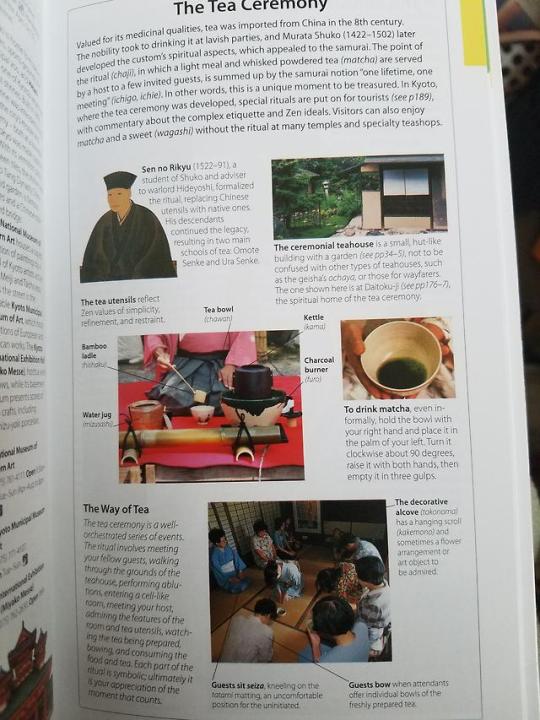
Here’s the page from my guidebook on Sen no Rikyu and chanoyu. Couldn’t figure out how to attach it to the blog post with the video. Please see previous post for written blog entry.
Source:
Eyewitness Travel - Japan Guidebook, printed 2017
0 notes